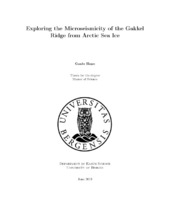Exploring the Microseismicity of the Gakkel Ridge from Arctic Sea Ice
Master thesis
Permanent lenke
https://hdl.handle.net/1956/6799Utgivelsesdato
2013-06-03Metadata
Vis full innførselSamlinger
- Department of Earth Science [1050]
Sammendrag
Monitoring of microseismicity is an important tool to understand the magmatism, tectonics and hydrothermal circulation of a mid-oceanic ridge. In the presence of sea ice, use of ocean bottom seismometers is not practical, but several experiments with small networks of seismometers drifting with the sea ice have previously been completed successfully. The goal of this project was to build on the earlier experiments and develop a method for monitoring the microseismicity above the Gakkel Ridge by developing seismic stations tailored for a small network on the Arctic sea ice. The new equipment has been taken from concept through development, building and deployment with data acquisition to data analysis. A 3D location algorithm was developed in order to locate a sample of the recorded events. Five prototype seismic stations were designed, built and tested in a small network on the sea ice. The stations had individual timing and positioning, and were connected in a wireless network for real time transmission of position, status and data. The network was deployed on the sea ice above the Gakkel Ridge at 85N during the FRAM-2012 expedition to the Arctic Ocean with the hovercraft R/H Sabvabaa in July - September 2012. The network drifted over the rift valley along with the ice and two re-deployments were made, totalling 23 days of recording. The last of the three deployments (7 days) was the most successful, with three of the buoys fully operational. Although technical challenges had to be overcome due to the prototype nature of the equipment, it proved practical and functional. The last deployment was analyzed and 41 events were identified. To account for the rough bathymetry at the Gakkel Ridge, a 3D grid search based location algorithm was developed, with which three of the events were located. The prototype and the experiences from the deployment are presented together with an overview of the recorded data, the location algorithm, results from data analysis with the three event locations and interpretations.
